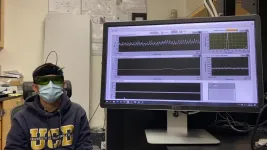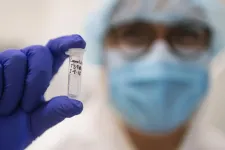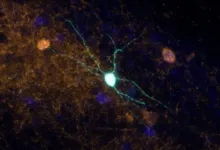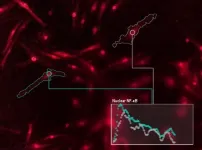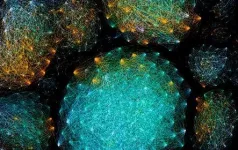(Press-News.org) A new, noninvasive method for measuring brain blood flow with light has been developed by biomedical engineers and neurologists at the University of California, Davis, and used to detect brain activation. The new method, functional interferometric diffusing wave spectroscopy, or fiDWS, promises to be cheaper than existing technology and could be used for assessing brain injuries, or in neuroscience research. The work is published May 12 in Science Advances.
"Now we can assess how well the brain regulates blood flow, and even detect brain activation noninvasively in adult humans, using principles similar to functional magnetic resonance imaging (fMRI), but at a fraction of the cost," said Vivek Srinivasan, adjunct associate professor of biomedical engineering at UC Davis and senior author on the study.
The human brain makes up 2% of our body weight but takes 15% to 20% of blood flow from the heart. Measuring cerebral blood flow is important for diagnosing strokes, and for predicting secondary damage in subarachnoid hemorrhages or traumatic brain injuries. Doctors who provide neurological intensive care, would also like to monitor a patient's recovery by imaging brain blood flow and oxygenation.
Existing technology is expensive and cannot be applied continuously or at the bedside. For example, current techniques to image cerebral blood flow require expensive MRI or computed tomography scanners. There are light-based technologies, such as near-infrared spectroscopy, but these also have drawbacks in accuracy.
The new method takes advantage of the fact that near-infrared light can penetrate through body tissues. If you shine a near-infrared laser on someone's forehead, the light will be scattered many times by tissue, including blood cells. By picking up the fluctuation signal of the light that finds its way back out of the skull and scalp, you can get information about blood flow inside the brain.
Naturally, that signal is extremely weak. Srinivasan and postdoctoral researcher Wenjun Zhou overcame that problem by making use of interferometry: the ability of light waves to superimpose, reinforcing or canceling one another. In particular, through interferometry, a strong light wave can boost a weak light wave by increasing its detected energy.
Prefrontal cortex activation
They first split the laser beam into "sample" and "reference" paths. The sample beam goes into the patient's head and the reference beam is routed so that it reconnects with the sample beam before going to the detector. Through interferometry, the stronger reference beam boosts the weak sample signal. This allowed the team to measure the output with the type of light-detecting chip found in digital cameras, instead of expensive photon counting detectors. They then use software to calculate a blood flow index for different locations in the brain.
Srinivasan and Zhou worked with Dr. Lara Zimmerman, Dr. Ryan Martin and Dr. Bruce Lyeth at the UC Davis Department of Neurological Surgery to test the technology. They found that with this new technology, they could measure blood flow more rapidly and deeper below the surface than with current light-based technology. They could measure pulsating cerebral blood flow and could also detect changes when volunteers were given a mild increase in carbon dioxide.
When volunteers were given a simple math problem, the researchers were able to measure activation of the prefrontal cortex through the forehead.
INFORMATION:
Additional authors on the paper are Oybek Kholiqov, Jun Zhu and Mingjun Zhao, all at the UC Davis Department of Biomedical Engineering. The work was supported by grants from the NIH. The university has applied for a patent on the technology.
MISSOULA - Only an anthropologist would treasure millennia-old human feces found in dry caves.
Just ask Dr. Meradeth Snow, a University of Montana researcher and co-chair of UM's Department of Anthropology. She is part of an international team, led by the Harvard Medical School-affiliated Joslin Diabetes Center, that used human "paleofeces" to discover that ancient people had far different microorganisms living in their guts than we do in modern times.
Snow said studying the gut microbes found in the ancient fecal material may offer clues to combat diseases like diabetes that afflict people living in today's industrialized societies.
"We ...
Researchers used genetic engineering tools to create a virus that can enter specific neurons and insert into the prefrontal cortex a new genetic code that induces the production of modified proteins. In tests with mice, the alteration of these proteins was sufficient to modify brain activity, indicating a potential biomarker for the diagnosis of psychiatric disorders such as schizophrenia and autism.
Sometimes referred to as the "executive brain", the prefrontal cortex is the region that governs higher-level cognitive functions and decision making. Studies of tissue from this brain region in patients with schizophrenia have detected alterations in two proteins: BDNF (brain-derived neurotrophic factor) and trkB (tyrosine receptor kinase B).
The relationship ...
A new study by the University of Georgia revealed that more college students change majors within the STEM pipeline than leave the career path of science, technology, engineering and mathematics altogether.
Funded by a National Institutes of Health grant and a National Science Foundation Postdoctoral Fellowship and done in collaboration with the University of Wisconsin, the study examined interviews, surveys and institutional data from 1,193 students at a U.S. midwestern university for more than six years to observe a single area of the STEM pipeline: biomedical fields of study.
Out of 921 students ...
UCLA life scientists have identified six "words" that specific immune cells use to call up immune defense genes -- an important step toward understanding the language the body uses to marshal responses to threats.
In addition, they discovered that the incorrect use of two of these words can activate the wrong genes, resulting in the autoimmune disease known as Sjögren's syndrome. The research, conducted in mice, END ...
A new study from North Carolina State University finds that greenhouse gas (GHG) emissions from standing dead trees in coastal wetland forests - colloquially called "tree farts" - need to be accounted for when assessing the environmental impact of so-called "ghost forests."
In the study, researchers compared the quantity and type of GHG emissions from dead tree snags to emissions from the soil. While snags did not release as much as the soils, they did increase GHG emissions of the overall ecosystem by about 25 percent. Researchers say the findings show snags are important for understanding the total environmental impact of the spread of dead trees in coastal wetlands, known as ghost forests, ...
The immune system's main job is identifying things that can make us sick. In the language of immunology, this means distinguishing "self" from "non-self": The cells of our organs are self, while disease-causing bacteria and viruses are non-self.
But what about the billions of bacteria that live in our guts and provide us with benefits like digesting food and making vitamins? Are they friend or foe?
This isn't only a philosophical question. An immune system that mistakes our good gut bacteria for an enemy can cause a dangerous type of inflammation in the intestines called colitis. An immune system that looks the other way while gut microbes spill past their assigned borders is equally dangerous. Understanding ...
Our body's relationship with bacteria is complex. While infectious bacteria can cause illness, our gut is also teaming with "good" bacteria that aids nutrition and helps keep us healthy. But even the "good" can have bad effects if these bacteria end up in tissues and organs where they're not supposed to be.
Now, research published in END ...
COLUMBUS, Ohio - Neighborhoods without opioid treatment providers likely serve as a widespread barrier to care for those who are ready to seek help, a new study has found.
The study, led by researchers at The Ohio State University, appears today (May 12, 2021) in the journal PLOS ONE.
"The study identified clear opioid treatment deserts that undoubtedly stand in the way of access to needed care and that likely exist throughout the state and the nation. These are areas where treatment providers should be setting up shop - we need a surge of resources into these areas," said Ayaz Hyder, an assistant professor in Ohio State's College of Public Health ...
Elephant Seals' Extreme Diving Allows Them to Exploit Deep Ocean Niche
Using data captured by video cameras and smart accelerometers attached to female elephant seals, Taiki Adachi and colleagues show that the animals spend at least 80% of their day foraging for fish, feeding between 1,000 and 2,000 times per day. The unique glimpse at elephant seal foraging strategy shows how these large marine mammals exploit a unique ocean niche filled with small fish. The findings also may offer a way to monitor the health of the mesopelagic zone, the dark and cold ocean "twilight zone" ecosystem at 200 to 1,000 meters deep. Small mesopelagic fish dominate the world's ocean ...
A Johns Hopkins University-led team has created an inexpensive portable device and cellphone app to diagnose gonorrhea in less than 15 minutes and determine if a particular strain will respond to frontline antibiotics.
The invention improves on traditional testing in hospital laboratories and clinics, which typically takes up to a week to deliver results--time during which patients can unknowingly spread their infections. The team's results appear today in Science Translational Medicine.
"Our portable, inexpensive testing platform has the potential to change the game when it comes to diagnosing and enabling rapid treatment of sexually transmitted infections," said team leader Tza-Huei Wang, a professor of mechanical engineering ...
